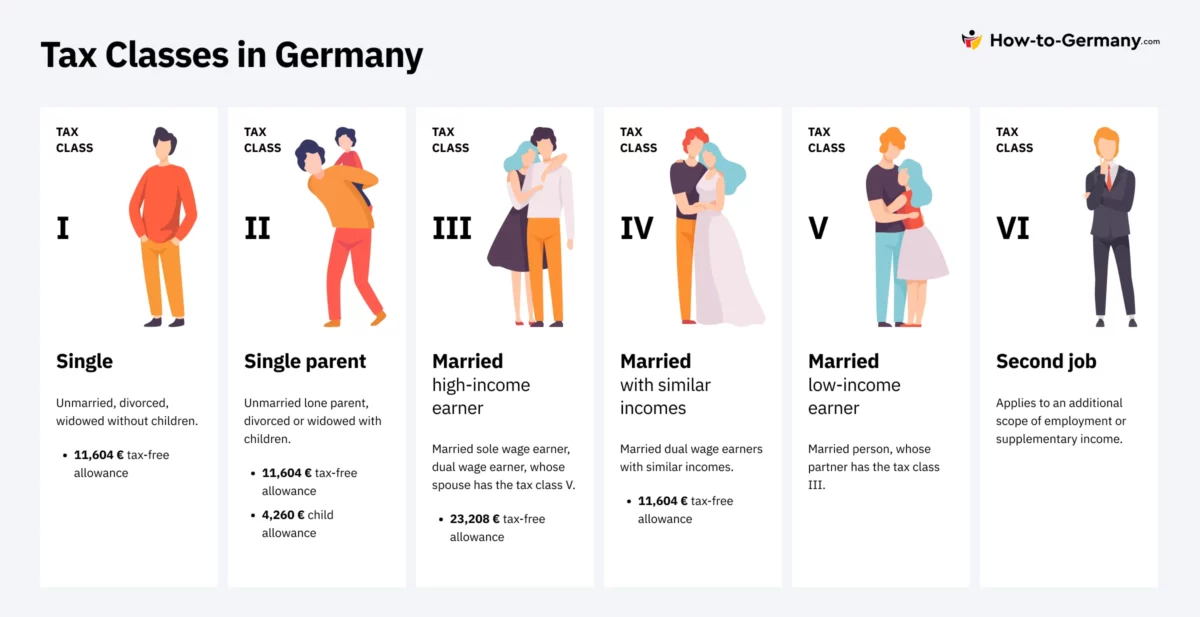Income Tax Classes in Germany
The income tax bracket you are assigned depends primarily on your marital status. Under certain circumstances, married couples can change their income tax class to save taxes. Here, you can learn everything about the wage tax classes and the distribution of taxpayers in the different tax classes.
What is meant by the wage tax class?
The amount of tax deducted from your wages depends on your tax bracket. Someone in wage tax class 1 has a different tax deduction than a taxpayer in wage tax class 2.
The tax class is entered as a wage tax deduction feature on your wage tax card. Today, the wage tax card is only available in electronic form. The tax class is, therefore, stored as ELStAM at the tax office. ELStAM stands for Elektronisches Lohnsteuer-Abzugsmerkmal and is the most crucial criterion for the amount of your tax deduction.
Which wage tax classes are there?
There are a total of six different wage tax classes (Wage tax classes 1 to 6) for wage and income tax in Germany. The individual wage tax classes differ primarily regarding marital status. In addition to the wage tax class, the amount of income is an essential criterion for the amount of taxes. Within a wage tax class, a taxpayer with a low income will pay less tax than someone with a high income. This ensures tax fairness, as so-called high earners pay more taxes than low earners.
Classification into tax classes
In the tax class 1 belong wedded, from their spouse separated living or already divorced employees. In a pending divorce, spouses must each register in tax class 1 if the joint residence is abandoned and two separate residences already exist.
The tax class 2 applies to single parents, provided that they are entitled to the relief amount for single parents. The tax office automatically takes the relief amount into account for the first child. If a single parent has more than one child there is a claim to a second or third relief amount; this must be applied for separately at the local tax office.
In the tax class 3 are spouses classified, who earn significantly more than the partner. The partner with the lower income is placed in tax class 5 as compensation. In the past, the combination of tax classes 3 and 5 was typical for most married couples when both partners were employed. As a rule, the man was classified in income tax class 3, and the woman was taxed in tax class 5 with a part-time income or significantly lower earnings. This model is no longer necessary today, as many married couples have comparable incomes.
Today, tax class 4 is automatically specified if both spouses are employed. Provided that there is no significant difference in the amount of income, this tax class combination is the most favorable. In tax class 4 there is a special feature: it can be selected with the principle “with factor”. This means that the tax office applies the advantage of spousal splitting already during the entire year. In doing so, the authority already calculates the tax liability of the married couple for all 12 months at the beginning of the year. It is then divided by the 12 months and paid to the tax office month by month in the form of income tax. This makes it easier to avoid paying back taxes.
The tax class 5 applies to spouses with the lower income, it is the counterpart to tax class 3.
In tax class 6 you will be taxed if you have two jobs subject to social insurance. In this case, one job is registered in wage tax class 6. Since this is a second income, the deductions in tax class 6 are quite high.
What wage tax class combinations are there for married couples?
Basically, spouses are taxed together if that is the more favorable option for you. For the deduction of the wage tax, however, only the respective own wage is always applied. At the end of the year, both incomes are combined so that the tax for the entire year results. As a consequence, it is almost impossible to avoid paying too much or too little tax during the year. This can result in a substantial back tax payment in the coming year. To avoid this, spouses can choose between two combinations of tax classes or make use of the factor method.
The combination that you have chosen once for yourself and your partner will continue to apply unchanged in the coming year – provided that the legal requirements continue to be met. Only the factor procedure in tax class 4 must be applied for again each year. Also, the change from the tax class combination 3 and 5 or 4 and 4 with and without factor procedure must be applied for at the tax office.
If you change the tax class, the tax office sets a deadline for this. At the latest on 30 November of the year the application must be at the tax office to apply retroactively for the entire year. The easiest way to make the change is to fill out the form “Application for tax class change for spouses” and submit it to the tax office in your city. The tax office will then change your tax class in the ELStAM system so that the tax is calculated accordingly retroactively and also applied for the next year.
What’s the deal with child allowances?
In tax bracket 2 there is a relief amount for single parents. It is granted to single employees who have at least one child living in their household. For the child, there must be an entitlement to child benefit or there must be an allowance for children. To qualify for the relief amount, the child must live with the taxpayer or have a secondary residence. The relief amount is 1,908 euros per year for the first child, with 240 euros added for each additional child. The child allowance is to be distinguished from the relief amount: It is 7,812 euros in 2020 and also covers the care, education and training amount for the taxpayer.
Summary on the income tax bracket
Although it may seem relatively complex at first glance, the system of wage tax brackets is relatively easy to understand upon closer inspection. Insofar as a choice of tax class is possible, you should carefully consider the alternatives. While it is not possible to make a blanket recommendation, there are certainly margins for maneuver.



